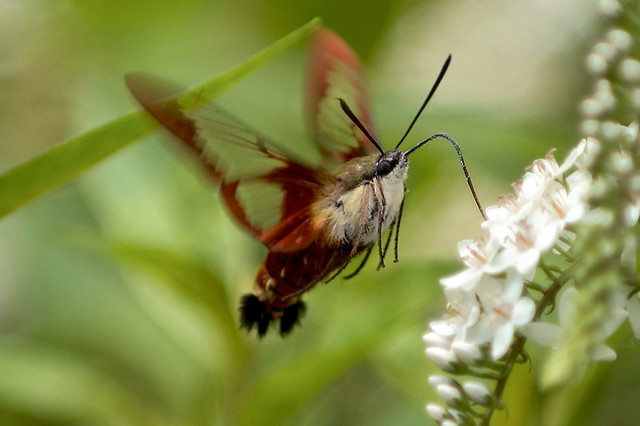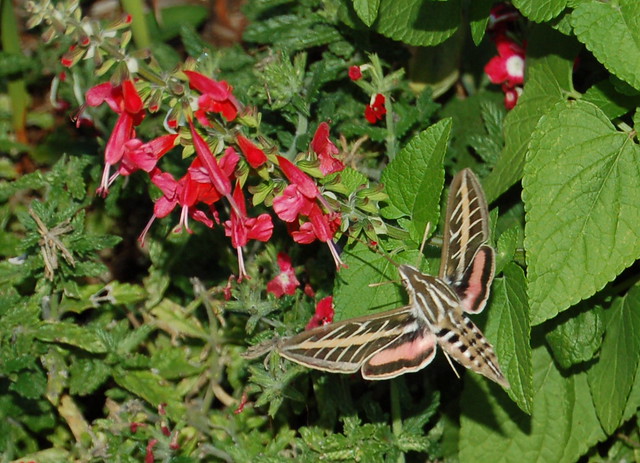 |
| Hummingbird Clearwing moth Photo by Joe Holmes |
Being a birder, I usually remember vividly where I was when a see a new bird for the first time, but seeing a new insect doesn’t usually stand out as well for me. Not so the hummingbird moth! I remember bright sunshine as I climbed up a small rise to a gravel road. There in the roadside wildflowers was the most bizarre sight. It behaved like be a hummingbird, but it was too small. It didn’t have the right attitude either. Hummingbirds often stand up vertically as they zip in and out of flowers. This creature was definitely visiting flowers, but it didn’t hold itself vertically. The wings weren’t right either. They were almost visible; hummingbird wings seem to disappear at times as they zoom past. Then the little creature disappeared.
It took some time to discover that my little mystery critter was a sphinx moth. Day-flying moths, the sphinx family feed on flower nectar. Some, like the Hummingbird Clearwing Moth, mimic the markings of bumblebees to discourage predators. They may look like bumblebees, but they behave like hummingbirds, using a proboscis instead of a long tongue to lap up the nectar of blossoms.
Their flight is faster and more direct than most moths—like a hummingbird, but not as fast by my reckoning. Like hummingbirds and bees, they are pollinators. According to David Wagner (Caterpillars of Eastern North America) the female Hummingbird Clearwing moth lays eggs on viburnum or honeysuckle and the bright green caterpillars thrive, growing to 2 inches. I haven’t found the caterpillars in my yard, though I grow both of these. I see the adults sometimes, so I’ll be on the lookout.
The Hummingbird Clearwing’s scientific name is Hemaris thysbe. According to the Bug Guide, the specific name of Thysbe was chosen because of the blood red color of the wing edges and tail of the moth. You would probably have to have a played a part in Shakespeare’s Midsummer Night’s Dream to remember that Thysbe’s veil was found by her lover Pyramus, blood-stained after a lion mouthed it. Poor Pyramus jumps to the conclusion that his darling is deceased and kills himself. I know it doesn’t sound funny, but it’s hysterical in the play. I prefer to believe that this moth was named for the comic reaction it provokes, rather than it’s rusty color.
 |
| White-lined Sphinx moth Photo by Katrina Wiese |
When people find that I’m interested in hummingbirds, they sometimes say, “Oh, yes, we had baby hummingbirds in our garden this summer.” However, my friend Lanny Chambers, a hummingbird bander, tells me that except for very minor differences, juvenile hummers are the same size as adults. A very small “hummingbird” is most likely a moth. Check out this fun website dedicated to hummingbird moths.
I just saw one of these in our garden. I didn't think it was a hummingbird because it had what looked like antennea. My husband thought it was a baby hummingbird. Glad to see that I am right again! :)
ReplyDeleteI have been seeing these in my yard. At first i too thought they were baby hummers but from up close they looked like a really large insects! Thank you for this very informative post!
ReplyDeleteI just saw one too in my flower bed. Came inside to find out what it is. As with the other folks, the first thought is hummingbird, and when that is looked up I come upon your description. Thanks for letting us know what it is!
ReplyDeleteSandra